Georgia, a state rich in history and culture, is home to numerous historic forts that have played significant roles in various periods of American history.
This article on historic forts in Georgia delves into some of them, each with its unique story and significance in the rich military history of Georgia and the United States.
Historic Forts in Georgia
| 1. Fort Frederica | 6. Fort Morris |
| 2. Fort Pulaski | 7. Ebenezer Fort |
| 3. Fort McAllister | 8. Fort Screven |
| 4. Old Fort Jackson | 9. Fort Hawkins |
| 5. Fort King George | 10. Fort McPherson |
1. Fort Frederica
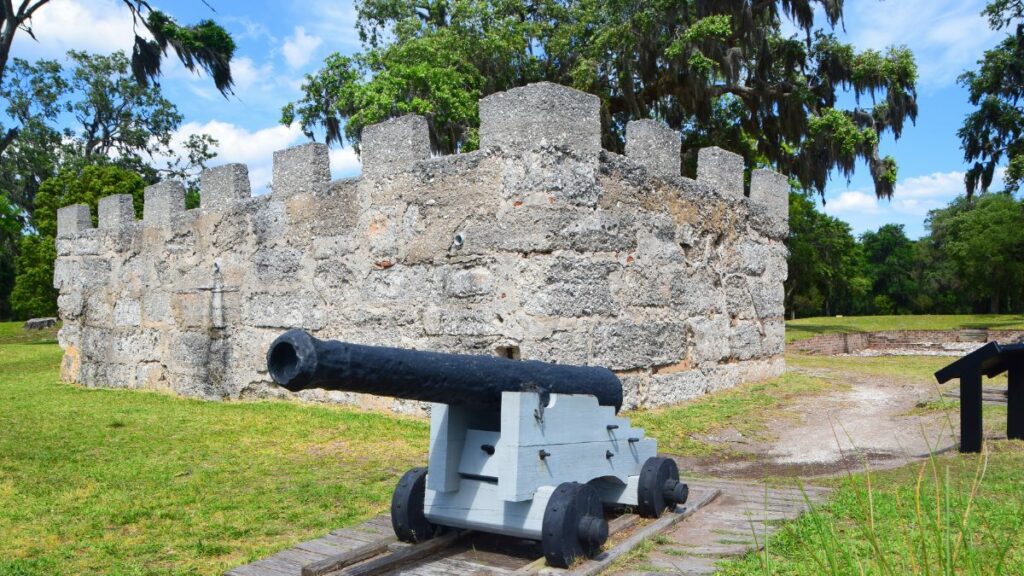
General James Oglethorpe established Fort Frederica in 1736 on St. Simons Island in Georgia.
It was primarily built to defend the southern boundary of the British colonies against Spanish invasions from Florida. This fortification played a pivotal role in the early defense strategies of North America.
Fort Frederica became especially crucial during the War of Jenkins’ Ear, a segment of the larger War of Austrian Succession from 1739 to 1748.
The Battle of Bloody Marsh 1742 near the fort marked a significant victory for Oglethorpe and the British forces, effectively securing the Georgia colony from Spanish threats.
Architectural Significance and Community Development
Constructed using tabby, a unique concrete made from lime, sand, and oyster shells, Fort Frederica was not just a military post but also a thriving community center.
At its height, it supported around 1,000 residents, encompassing soldiers and civilians, and reflected the region’s architectural and cultural ethos.
Decline and Preservation
The fort’s importance diminished as the threat from Spanish Florida receded. By 1758, the British military had left, leading to a decline in the population.
Today, it is a National Historic Landmark, with its ruins providing insights into 18th-century military architecture and life.
The site now houses a museum, displaying a range of artifacts and exhibits that narrate the history of Fort Frederica and the broader colonial conflicts in North America.
The landmark is also a center for educational programs and tours, highlighting its historical significance in the region and the country’s past.
2. Fort Pulaski
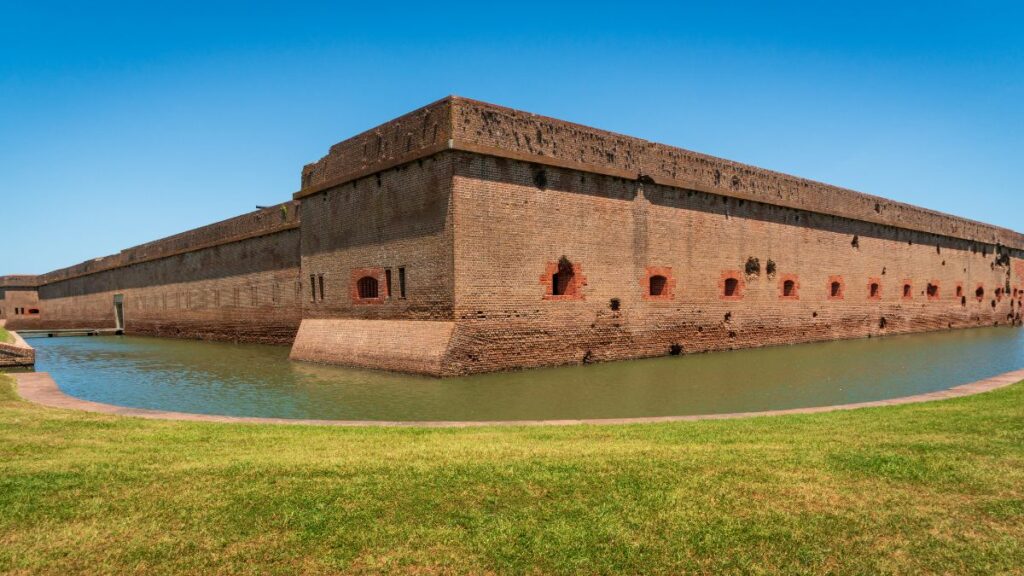
Fort Pulaski National Monument is located near the mouth of the Savannah River on Cockspur Island.
This fortification was constructed as a defensive structure to protect the city of Savannah, Georgia. Its strategic placement was crucial for controlling access to the river.
Significance during the American Civil War
Fort Pulaski became a pivotal site during the American Civil War. The fort fell into Confederate hands early in the war and was a critical defensive position.
However, in 1862, Union forces successfully used rifled cannons in a siege, which led to the fort’s capture.
This event was historically significant as it demonstrated the effectiveness of rifled cannons against traditional masonry fortifications, signaling the end of such defensive structures’ relevance in modern warfare.
Union forces’ siege of Fort Pulaski marked a turning point in military technology. Rifled cannons, which had greater accuracy and power, resulted in the rapid breaching of the fort’s previously thought impenetrable walls.
This event dramatically changed military engineering and fortification strategies in the future.
Preservation and Current Use
After the Civil War, Fort Pulaski underwent periods of neglect and restoration. It was designated a National Monument and incorporated into the National Park Service.
Today, the monument is open to the public and offers a range of activities and educational opportunities. Visitors can enjoy public tours that delve into the fort’s history and role in the Civil War.
The monument features a fascinating Civil War museum providing detailed insights into the fort’s history and broader context.
Additionally, there is a nature trail for visitors to explore the surrounding natural beauty of Cockspur Island. The combination of historical education and natural exploration makes Fort Pulaski a unique and enriching destination.
3. Fort McAllister
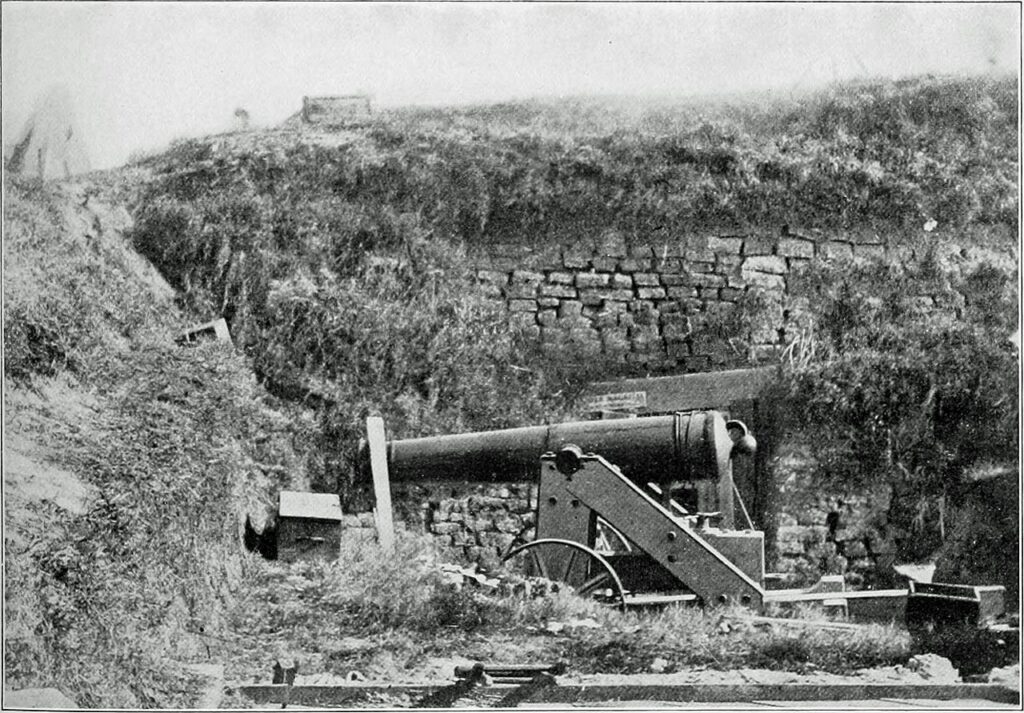
Fort McAllister is strategically located overlooking the banks of the Ogeechee River.
This positioning was crucial for its role in the American Civil War, as it allowed Confederate forces to monitor and control naval traffic along the river and defend against Union advances, particularly from the direction of South Carolina.
Role in the Civil War
During the Civil War, Fort McAllister played a significant role in defending against Union army advances. It was an earthen fort, a fortification made primarily from earth and timber.
This construction style made it more resilient against artillery fire than traditional masonry forts. Fort McAllister is noted for its strategic importance and remarkable resilience against numerous attacks by Union troops.
One of the defining features of Fort McAllister was its ability to withstand several assaults by Union forces.
Despite being under-equipped and outnumbered, the fort’s defenders repelled attacks effectively until the final assault in December 1864, when it was finally captured by Union forces led by General William Tecumseh Sherman during his famous “March to the Sea.”
Preservation as a Historic Park
Today, Fort McAllister has been preserved as part of a historic park. This site offers visitors a glimpse into the life of Confederate troops during the Civil War.
Preserving the earthen fortifications provides a tangible connection to the past, allowing visitors to understand the era’s living conditions and military strategies.
The park surrounding Fort McAllister includes a large picnic area, making it a popular spot for educational and recreational visits.
Visitors can explore the fort’s remains and learn about the Civil War’s military tactics and soldiers’ daily lives.
The park’s natural setting along the Ogeechee River also adds to its appeal, providing a serene backdrop for learning about this significant historical period.
4. Old Fort Jackson

Old Fort Jackson, located a short distance from historic Savannah, is Georgia’s oldest brick fortification. Its history is deeply intertwined with the military and cultural developments of the region.
During the American Civil War, Old Fort Jackson saw considerable action and played a critical role. It served as a key defense point against Union forces, becoming an integral part of Savannah’s defensive system.
The fort’s strategic location and robust construction made it a vital asset for the Confederacy during the war.
Action and Defense Strategies
Old Fort Jackson was involved in several military engagements throughout the Civil War. Its primary role was to protect Savannah from naval attacks.
Despite facing formidable Union naval and land forces, the fort held its position for much of the war, illustrating its defenders’ strategic prowess and resilience.
After the war, Old Fort Jackson was preserved as a historic site. This preservation allows visitors to step back in time and explore a crucial piece of Georgia’s, and indeed America’s, military history.
The fort’s brickwork and design, characteristic of the period, vividly represent 19th-century military architecture.
Educational and Recreational Activities
Today, Old Fort Jackson offers a range of activities and events that bring its history to life. Visitors can experience daily cannon firings, a unique and engaging way to understand past military operations.
The site also features a gift shop, where visitors can purchase memorabilia and educational materials. Additionally, special events are regularly held to showcase the fort’s significant role in Savannah’s history and the broader context of the Civil War.
Old Fort Jackson serves as a reminder of the military strategies and conflicts of the Civil War and a cultural landmark. It helps educate the public about the complexities of the war and the region’s history, making it a valuable resource for historians and casual visitors.
5. Fort King George

Fort King George, recognized as the oldest British fort in Georgia, is located near the mouth of the Altamaha River.
It was established as a strategic military outpost, serving a crucial role in frontier defense during a period marked by European colonial expansion and conflict in the New World.
During its operational period, Fort King George was primarily tasked with defending the British colonial territories against potential Spanish and French invasions.
This role was pivotal in the geopolitical landscape of the time, where European powers were vying for control over North American territories.
Architectural Features and Surrounding Environment
The fort is notable for its cypress blockhouse, which illustrates the period’s architectural style and construction techniques.
The surrounding environment, including a shaded campground and the salt marsh, adds to the historical ambiance of the site.
These elements provide a tangible connection to the past, giving visitors a sense of the natural conditions and challenges faced by the British soldiers and colonial settlers.
Fort King George not only represents military history but also tells the story of the incredible hardships endured by the British soldiers and the early colonial settlers in the region.
The fort’s rich history includes harsh conditions, isolation, and threats from rival powers.
Preservation as a State Historic Site
Now preserved as a state historic site, Fort King George offers a comprehensive look into 18th-century frontier fortification practices. The preservation efforts have ensured that this vital piece of history remains accessible for public education and appreciation.
Fort visitors can learn about Colonel “Tuscarora Jack” and His Majesty’s Independent Company, providing insights into the military and social aspects of the time.
The site’s educational programs, reenactments, and exhibits offer a deep dive into the everyday life, struggles, and resilience of those who lived and served in the fort.
In addition to its historical significance, Fort King George is a cultural and recreational destination. It provides a unique opportunity for visitors to immerse themselves in the history of colonial Georgia and experience the area’s natural beauty.
6. Fort Morris
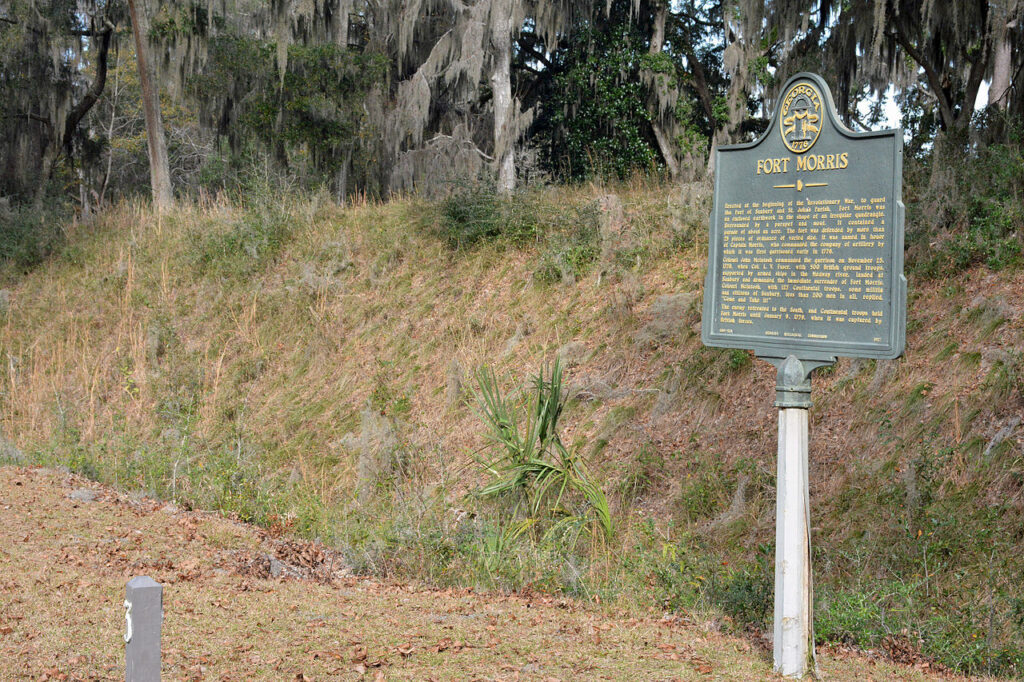
Fort Morris, nestled in Liberty County, Georgia, was a significant military site from 1741 to the end of the Civil War 1865.
The fort, strategically situated on a bend in the Medway River, was primarily an earthen construction.
It played a vital role in defending southeast Georgia through several historical periods, including the French and Indian War, the American Revolutionary War, and the War of 1812.
The earliest fortification at this location was built in 1741 to protect Captain Mark Carr’s plantation. This fort came under attack by Native American allies of the Spanish forces from Florida.
Later, during the French and Indian War, a new fort was constructed in 1756 due to local concerns about Creek Indian uprisings. This fort expanded in 1758, protecting Sunbury’s burgeoning settlement significantly.
Revolutionary War and Beyond
The American Revolutionary War brought renewed importance to the site. Fort Morris, authorized by the Continental Congress, served as a base for operations against British Florida before becoming a defensive stronghold.
The fort is notably remembered for Colonel John McIntosh’s defiant response, “Come and take it!” to a British demand for surrender in 1778. Despite British forces capturing it in 1779, the fort symbolized the colonial resistance.
Following the Revolutionary War, the fort fell into disrepair. Still, it gained prominence again during the War of 1812, when Fort Defiance was built on its site in 1814- although this fort was left unfinished at the war’s end.
Today, Fort Morris is a preserved state park recognized in the National Register of Historic Places, offering visitors a glimpse into its layered and diverse military history.
This site reminds us of the strategic military maneuvers and resilience of those who defended the region across different historical epochs.
7. Ebenezer Fort
Ebenezer Fort, founded in 1757, was a critical military structure in colonial Georgia, primarily established to safeguard a settlement of German immigrants. Situated in Effingham County, this fort was integral to the region’s defense and was a vital hub for the silk trade.
Initially laid out in 1734, the town of Ebenezer rapidly developed around the fort. The fort’s significance escalated during the American Revolution, especially after 1776, when the Continental Army enhanced its defenses and added a militia magazine.
The fort witnessed several changes of control during the war; it was seized by British forces in 1779 and endured over three years of British occupation, leading to considerable hardship for the local populace.
In a pivotal turn of events in 1782, American forces reclaimed Ebenezer, aligning with the British surrender of Savannah.
This period marked a notable phase in the town’s history, briefly becoming Georgia’s capital and serving as the Effingham County seat until 1799.
Ebenezer Fort’s historical narrative, marked by its establishment, strategic role in trade and defense, and significance in the Revolutionary War, highlights the Georgian colonial frontier’s complex military and socio-economic dynamics.
8. Fort Screven
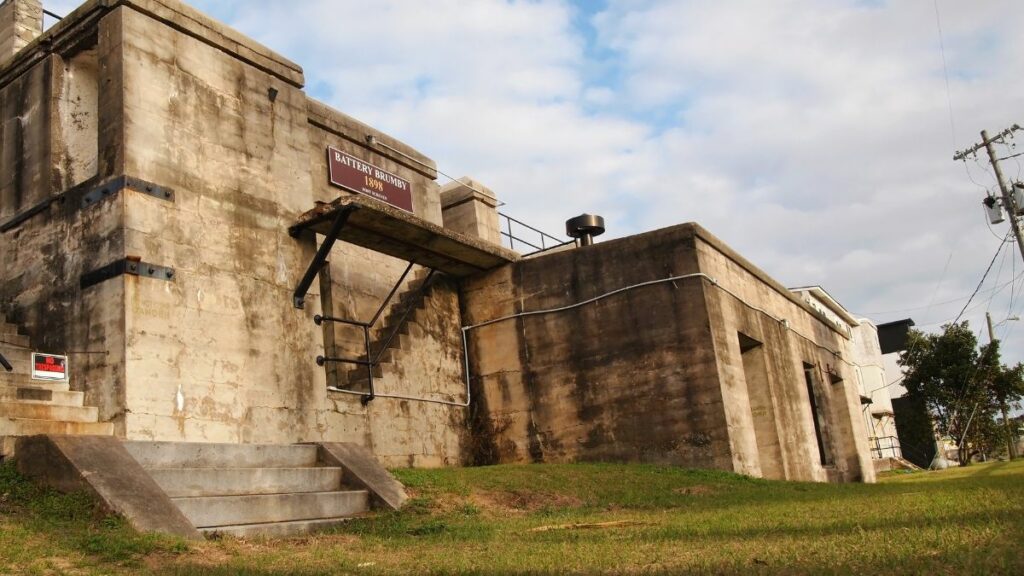
Fort Screven, situated on Tybee Island in Georgia, carries a rich historical legacy that begins with the American Revolution.
It was named in honor of Brigadier General James Screven, a celebrated figure in the Revolutionary War. The Georgia Legislature authorized its construction in 1786, marking the initial steps in its long-standing history.
The actual construction of Fort Screven commenced much later, in the late 19th century. This timing aligned with the Endicott System, an expansive initiative by the United States to modernize and reinforce coastal defenses.
The system responded to advancements in naval warfare technology and the evolving national defense requirements.
Military Roles and Significance
Over the years, Fort Screven played various critical roles in American military history. It was a key player during the Spanish-American War and both World Wars.
It served in various capacities, including as a coast artillery fort, an infantry post, and, uniquely, as a school for deep-sea diving. These diverse roles underscore the fort’s adaptability and importance in different military contexts.
Notable structures within Fort Screven, such as Battery Garland, have been preserved and repurposed for public education and engagement.
These structures house facilities like the Tybee Island Museum today, offering visitors a window into the fort’s extensive and varied history. This preservation effort commemorates the fort’s past and serves as a medium for educating future generations.
9. Fort Hawkins
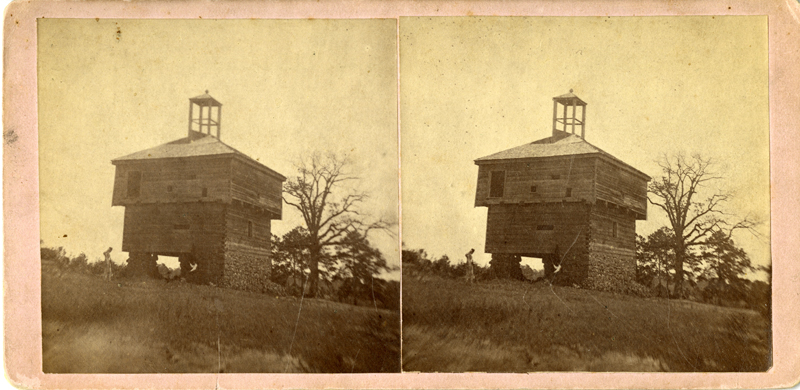
Fort Hawkins, named in honor of Benjamin Hawkins, a notable U.S. Indian agent and senator, played a significant role in the early 19th-century American frontier.
Established in 1806 near present-day Macon, Georgia, the fort was a frontier post on the Ocmulgee River. Its primary purpose was to oversee trade and interaction with the Native American Creek Nation and to act as a defensive stronghold in the Southern frontier.
The fort’s strategic location made it a key military outpost during the early 1800s. It was actively involved in the Creek Wars (1813-1814), a series of conflicts between American settlers and the Creek Nation.
Fort Hawkins served as a central hub for military operations, supply, and communications during this tumultuous period, significantly impacting the regional dynamics and outcomes of these conflicts.
Role in Western Expansion and Indian Affairs
Apart from its military functions, Fort Hawkins was integral in overseeing and facilitating the U.S. government’s interactions with Native American tribes.
It played a crucial role in the implementation of U.S. policies towards Native Americans, including treaties and land agreements, which were pivotal during the era of westward expansion.
The fort was key for diplomatic negotiations and meetings with tribal leaders.
Decline and Transformation
After its active military use, Fort Hawkins saw a decline in its strategic importance. With the shifting frontiers and evolving military needs, the fort gradually ceased to be a central military outpost.
Over time, it transformed into a trading post and a local community center, reflecting the changing landscape of American society and the frontier.
Preservation and Modern Recognition
Today, Fort Hawkins is recognized for its historical significance, with efforts made to preserve and commemorate its legacy.
It serves as a historical site, offering insights into early 19th-century American military history, frontier life, and interactions between the U.S. government and Native American nations.
The site provides educational opportunities and is a point of interest for those looking to understand the complexities of American history during a period of expansion and conflict.
10. Fort McPherson
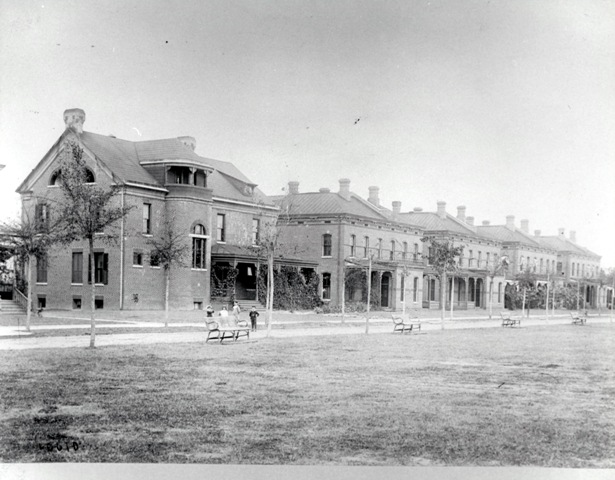
Fort McPherson, located in Atlanta, Georgia, was established in 1885.
Named after Major General James Birdseye McPherson, a Union Army officer killed during the Civil War, the fort was initially designed as a base for U.S. Army operations in the southeastern United States.
Its establishment reflected the post-Civil War expansion and reorganization of the U.S. military.
Throughout its history, Fort McPherson served as a central hub for military training and operations. It was home to various Army commands and units, pivotal in preparing troops for various conflicts.
The fort’s strategic location in the South made it an ideal training ground for soldiers, offering a range of terrains and climates for comprehensive military preparation.
World Wars and Expansion
Fort McPherson was instrumental in the U.S. military efforts during World War I and II. It expanded significantly during these times, hosting training facilities, administrative offices, and medical facilities.
The fort was vital in mobilizing, training, and deploying troops, as well as in the rehabilitation of wounded soldiers.
Cold War Era and Later Developments
Fort McPherson continued to play a crucial role in the Cold War era. It adapted to the changing nature of military threats and strategies, serving as a command center and logistics base.
The fort also housed important military research and development initiatives, contributing to military technology and strategy advancements.
Closure and Legacy
Fort McPherson was officially closed in 2011 as part of the Base Realignment and Closure (BRAC) process, reflecting the evolving needs and structures of the U.S. military.
Since its closure, parts of the fort have been repurposed for civilian use, including redevelopment projects and community initiatives.
The historical significance of Fort McPherson lies in its century-long service as a critical military installation. It played a vital role in the training and deploying of U.S. forces across multiple conflicts and was instrumental in evolving military strategies and technologies.
The fort’s history reflects the broader narrative of American military development and its impact on the nation’s defense capabilities.
Today, as a site of historical and cultural importance, Fort McPherson continues to be a point of interest for those studying military history and urban redevelopment.
Related: Army Forts in Georgia
Conclusion – Historic Forts in Georgia
This journey through Georgia’s historic forts provides a comprehensive view of the state’s crucial role in shaping American history, from the 18th century through the Civil War.
These forts, once the scene of battles and significant military strategy, now serve as poignant reminders of the past and sites where history enthusiasts can learn and reflect.
Thanks for reading. If you have visited any of these forts, we would love to hear about your experience in the comments section below.

Cory is a website owner and content creator who enjoys fishing, history, coin collecting, and sports, among other hobbies. He is a husband and father of four.
Romans 15:4 For whatever was written in former days was written for our instruction, that through endurance and through the encouragement of the Scriptures we might have hope.

